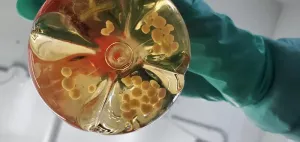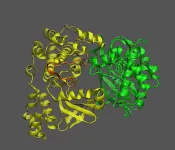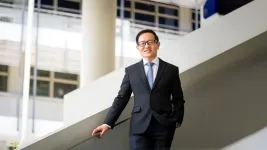(Press-News.org) A lack of detailed record-keeping in clinics and emergency departments may be getting in the way of reducing the inappropriate use of antibiotics, a pair of new studies by a pair of University of Michigan physicians and their colleagues suggests.
In one of the studies, about 10% of children and 35% of adults who got an antibiotic prescription during an office visit had no specific reason for the antibiotic in their record.
The rate of this type of prescribing is especially high in adults treated seen in emergency departments and in adults seen in clinics who have Medicaid coverage or no insurance, the studies show. But the issue also occurs in children.
Without information about what drove these inappropriate prescriptions, it will be even harder for clinics, hospitals and health insurers to take steps to ensure that antibiotics are prescribed only when they’re really needed, the researchers say.
Overuse and misuse of antibiotics raise the risk that bacteria will evolve to resist the drugs and make them less useful for everyone. Inappropriately prescribed antibiotics may also end up doing more harm than good to patients.
“When clinicians don’t record why they are prescribing antibiotics, it makes it difficult to estimate how many of those prescriptions are truly inappropriate, and to focus on reducing inappropriate prescribing,” said Joseph Ladines-Lim, M.D., Ph.D., first author of both of the new studies and a combined internal medicine/pediatrics resident at Michigan Medicine, U-M’s academic medical center.
“Our studies help contextualize the estimates of inappropriate prescribing that have been published previously,” he added. “Those estimates don’t distinguish between antibiotic prescriptions that are considered inappropriate due to inadequate coding and antibiotic prescriptions truly prescribed for a condition that they can’t treat.”
Ladines-Lim worked with U-M pediatrician and health care researcher Kao-Ping Chua, M.D., Ph.D., on the new studies. The one on outpatient prescribing by insurance status is in the Journal of General Internal Medicine and the one on trends in emergency department prescribing is in Antimicrobial Stewardship and Healthcare Epidemiology.
Building on previous research
Chua and colleagues recently published findings about trends in inappropriate antibiotic prescribing in outpatients under age 65, suggesting about 25% were inappropriate. But that number includes antibiotic prescriptions written for infectious conditions that antibiotics don’t help, such as colds, and antibiotic prescriptions that aren’t associated with any diagnoses that could be a plausible antibiotic indication.
The new studies add more nuance to that finding, by looking more closely at these two different types of inappropriate prescriptions.
Most antibiotic stewardship efforts to date have focused on reducing the use of the first type of inappropriate prescription – those written for infectious but antibiotic-inappropriate conditions like colds. The new studies show such patients still account for 9% to 22% of all antibiotic prescriptions, depending on the setting and age group.
But since doctors and other prescribers aren’t required to run a test for a bacterial infection or list a specific diagnosis in order to prescribe antibiotics, symptoms provide potential clues to why they might have written a prescription anyway.
So some of those 9% to 22% of all people receiving antibiotics may have also had a secondary bacterial infection that the clinician suspected based on symptoms.
However, it’s impossible to know.
As for those with no infection-related diagnoses or symptoms in their records who got antibiotics, the researchers suggest that clinicians may not have bothered to add these diagnoses or symptoms to the patient record inadvertently – or even deliberately, to try to avoid the scrutiny of antibiotic watchdogs.
But the researchers also speculate that the lower rate of diagnosis documentation in patients in the healthcare safety net may also have to do with the way healthcare organizations are reimbursed.
Often, clinics and hospitals receive a fixed amount from Medicaid to care for all their patients with that type of coverage. So they aren’t incentivized to create records that are as detailed as for privately insured patients, whose care traditionally is reimbursed under a fee-for-service model.
“This could actually be a matter of health equity if people with low incomes or no insurance are being treated differently when it comes to antibiotics,” says Ladines-Lim, who has also studied antibiotic use related to immigrant and asylum-seeker health and will soon begin a fellowship in infectious diseases.
He said that private and public insurers, and health systems, may need to incentivize accurate diagnosis coding for antibiotic prescriptions – or at least make it easier for providers to document why they’re giving them.
That might even include steps such as requiring providers to record the reason for antibiotic prescribing before prescriptions can be sent to pharmacies through electronic health record systems.
After all, Ladines-Lim said, physicians often have to list a diagnosis that justifies tests they order, such as CT scans or x-rays. With antibiotic resistance posing an international threat to patients who have antibiotic-susceptible conditions, similar steps to justify prescriptions of antibiotics might be advisable.
In addition to Ladines-Lim and Chua, the other authors of the two articles are Michael A. Fischer, M.D., M.S. of Boston Medical Center and Boston University, and Jeffrey A. Linder, M.D., M.P.H. of Northwestern University Feinberg School of Medicine.
Chua is a member of the Susan B. Meister Child Health Evaluation and Research Center, and the U-M Institute for Healthcare Policy and Innovation.
The research was funded by a Resident Research Grant from the American Academy of Pediatrics, a Physician Investigator Award from Blue Cross Blue Shield Foundation of Michigan, and a Research Grant from the National Med-Peds Residents’ Association.
Prevalence of Inappropriate Antibiotic Prescribing with or without a Plausible Antibiotic Indication among Safety-Net and Non-Safety Net Populations, Journal of General Internal Medicine - https://link.springer.com/article/10.1007/s11606-024-08757-z
Appropriateness of Antibiotic Prescribing in US Emergency Department Visits, 2016–2021; Antimicrobial Stewardship and Healthcare Epidemiology https://doi.org/10.1017/ash.2024.79
END
Better medical record-keeping needed to fight antibiotic overuse, studies suggest
Many who get antibiotics in clinics & emergency departments have no diagnosis or symptoms that might explain a prescription; improved diagnosis coding could help target efforts to optimize use & reduce risk
2024-05-17
ELSE PRESS RELEASES FROM THIS DATE:
Clinicians report success with first test of drug in a patient with life-threatening blood clotting disorder
2024-05-17
Key Takeaways
Immune thrombotic thrombocytopenic purpura, a rare blood clotting disorder, results from an autoimmune attack against an enzyme called ADAMTS13
A recombinant form of human ADAMTS13 approved for a different condition helped to save the life of a young mother with immune thrombotic thrombocytopenic purpura
Results from this first use of the drug for this condition—by a team led by researchers from Massachusetts General Hospital—warrants testing the drug in a clinical trial
A team led by investigators from Massachusetts General Hospital, a founding member of the Mass General Brigham healthcare system, used a new drug to save the life of a patient ...
NIH study shows chronic wasting disease unlikely to move from animals to people
2024-05-17
WHAT:
A new study of prion diseases, using a human cerebral organoid model, suggests there is a substantial species barrier preventing transmission of chronic wasting disease (CWD) from cervids—deer, elk and moose—to people. The findings, from National Institutes of Health scientists and published in Emerging Infectious Diseases, are consistent with decades of similar research in animal models at the NIH’s National Institute of Allergy and Infectious Diseases (NIAID).
Prion diseases are degenerative diseases found in some mammals. These diseases primarily involve deterioration of the brain but also can affect the eyes and other organs. ...
Scientists discover mechanism of sugar signaling in plants
2024-05-17
UPTON, N.Y. — Proteins are molecular machines, with flexible pieces and moving parts. Understanding how these parts move helps scientists unravel the function a protein plays in living things — and potentially how to change its effects. Biochemists at the U.S. Department of Energy’s (DOE) Brookhaven National Laboratory and colleagues at DOE’s Pacific Northwest National Laboratory (PNNL) have just published a new example of how one such molecular machine works.
Their paper in the journal Science Advances describes how the moving parts of ...
Cleveland Clinic research finds VISTA directly blocks T-cells from functioning in immunotherapy
2024-05-17
A Cleveland Clinic-led team of scientists and physicians have discovered that the immune checkpoint protein VISTA can directly turn off tumor-fighting T-cells during immunotherapy and resist treatment.
The study, published in Science Immunology, explains that VISTA can bind to a protein called LRIG1 in T cells, which was previously only thought to promote bone and fat development. When VISTA binds to LRIG1, the researchers found, LRIG1 sends signals that suppress T cell replication, survival ...
Pagan-Christian trade networks supplied horses from overseas for the last horse sacrifices in Europe
2024-05-17
Horses crossed the Baltic Sea in ships during the Late Viking Age and were sacrificed for funeral rituals, according to research from Cardiff University.
Published in the journal Science Advances, studies on the remains of horses found at ancient burial sites in Russia and Lithuania show that they were brought overseas from Scandinavia utilising expansive trade networks connecting the Viking world with the Byzantine and Arab Empires.
Up to now, researchers had believed sacrificial horses were always locally-sourced stallions. ...
University of Bristol researchers develop world’s smallest quantum light detector on a silicon chip
2024-05-17
Researchers at the University of Bristol have made an important breakthrough in scaling quantum technology by integrating the world’s tiniest quantum light detector onto a silicon chip.
A critical moment in unlocking the information age was when scientists and engineers were first able to miniaturise transistors onto cheap micro-chips in the 1960s.
Now, for the first time, University of Bristol academics have demonstrated the integration of a quantum light detector – smaller than a human hair – onto a silicon chip, moving us one step closer to the age of quantum technologies using light.
Making high performance electronics ...
Gut bacteria boost immune response to fight tumors
2024-05-17
Roughly one in five cancer patients benefits from immunotherapy – a treatment that harnesses the immune system to fight cancer. Such an approach to beating cancer has seen significant success in lung cancer and melanoma, among others. Optimistic about its potential, researchers are exploring strategies to improve immunotherapy for cancers that don’t respond well to the treatment, with the hope of benefiting more patients.
Now, researchers at Washington University School of Medicine in St. Louis have found, in ...
How heatwaves are affecting Arctic phytoplankton
2024-05-17
The basis of the marine food web in the Arctic, the phytoplankton, responds to heatwaves much differently than to constantly elevated temperatures. This has been found by the first targeted experiments on the topic, which were recently conducted at the Alfred Wegener Institute’s AWIPEV Station. The phytoplankton’s behaviour primarily depends on the cooling phases after or between heatwaves, as shown in a study just released in the journal Science Advances.
Heatwaves, which we’ve increasingly seen around the globe in recent years, are also becoming more and ...
NUS scientist Professor Lim Chwee Teck elected Fellow of the Royal Society
2024-05-17
Professor LIM Chwee Teck, Director of the Institute for Health Innovation & Technology at the National University of Singapore (NUS iHealthtech) and NUSS Professor, has been elected to the prestigious Fellowship of the Royal Society, in recognition of his invaluable contributions to science.
The Royal Society is the world's oldest and most esteemed scientific academy in continuous existence, as well as the United Kingdom’s national academy of sciences. Fellows are elected annually, and candidates are evaluated based on their exceptional achievements in science. This ...
Modern plant enzyme partners with surprisingly ancient protein
2024-05-17
UPTON, N.Y. — Scientists from the U.S. Department of Energy’s (DOE) Brookhaven National Laboratory have discovered that a protein responsible for the synthesis of a key plant material evolved much earlier than suspected. This new research explored the origin and evolution of the biochemical machinery that builds lignin, a structural component of plant cell walls with significant impacts on the clean energy industry.
When the first land plants emerged from aquatic environments, they needed to adapt in order to survive.
Chang-Jun Liu, a senior scientist in Brookhaven’s Biology ...
LAST 30 PRESS RELEASES:
Scientists trace microplastics in fertilizer from fields to the beach
The Lancet Obstetrics, Gynecology, & Women’s Health: Taking paracetamol during pregnancy does not increase risk of autism, ADHD or intellectual disabilities, confirms new gold-standard evidence review
Taking paracetamol during pregnancy does not increase risk of autism, ADHD or intellectual disabilities
Harm reduction vending machines in New York State expand access to overdose treatment and drug test strips, UB studies confirm
University of Phoenix releases white paper on Credit for Prior Learning as a catalyst for internal mobility and retention
Canada losing track of salmon health as climate and industrial threats mount
Molecular sieve-confined Pt-FeOx catalysts achieve highly efficient reversible hydrogen cycle of methylcyclohexane-toluene
Investment in farm productivity tools key to reducing greenhouse gas
New review highlights electrochemical pathways to recover uranium from wastewater and seawater
Hidden pollutants in shale gas development raise environmental concerns, new review finds
Discarded cigarette butts transformed into high performance energy storage materials
Researchers highlight role of alternative RNA splicing in schizophrenia
NTU Singapore scientists find new way to disarm antibiotic-resistant bacteria and restore healing in chronic wounds
Research suggests nationwide racial bias in media reporting on gun violence
Revealing the cell’s nanocourier at work
Health impacts of nursing home staffing
Public views about opioid overdose and people with opioid use disorder
Age-related changes in sperm DNA may play a role in autism risk
Ambitious model fails to explain near-death experiences, experts say
Multifaceted effects of inward foreign direct investment on new venture creation
Exploring mutations that spontaneously switch on a key brain cell receptor
Two-step genome editing enables the creation of full-length humanized mouse models
Pusan National University researchers develop light-activated tissue adhesive patch for rapid, watertight neurosurgical sealing
Study finds so-called super agers tend to have at least two key genetic advantages
Brain stimulation device cleared for ADHD in the US is overall safe but ineffective
Scientists discover natural ‘brake’ that could stop harmful inflammation
Tougher solid electrolyte advances long-sought lithium metal batteries
Experts provide policy roadmap to reduce dementia risk
New 3D imaging system could address limitations of MRI, CT and ultrasound
First-in-human drug trial lowers high blood fats
[Press-News.org] Better medical record-keeping needed to fight antibiotic overuse, studies suggestMany who get antibiotics in clinics & emergency departments have no diagnosis or symptoms that might explain a prescription; improved diagnosis coding could help target efforts to optimize use & reduce risk






